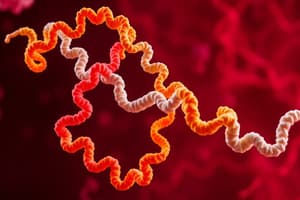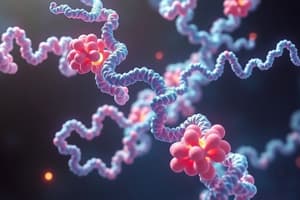Podcast
Questions and Answers
What primarily determines the conformational structure of proteins?
What primarily determines the conformational structure of proteins?
- Polypeptide chain length and molecular weight
- Presence of metal ions and pH levels
- Temperature and pressure conditions
- Amino acid sequence and environmental conditions (correct)
What is the function of molecular chaperones like Hsp70?
What is the function of molecular chaperones like Hsp70?
- To stabilize hydrophobic regions of proteins during folding (correct)
- To cleave peptide bonds in polypeptide chains
- To facilitate the enzymatic activity of proteins
- To provide a structural framework for protein synthesis
Which level of protein structure involves multiple polypeptide subunits?
Which level of protein structure involves multiple polypeptide subunits?
- Tertiary structure
- Secondary structure
- Primary structure
- Quaternary structure (correct)
How does denaturation affect a protein's functionality?
How does denaturation affect a protein's functionality?
Which structural feature is NOT a characteristic of peptide bonds?
Which structural feature is NOT a characteristic of peptide bonds?
What is the main interaction that leads to the formation of quaternary structure in proteins?
What is the main interaction that leads to the formation of quaternary structure in proteins?
How many amino acids are included in each complete turn of an alpha helix?
How many amino acids are included in each complete turn of an alpha helix?
In the formation of a peptide bond, which groups of the amino acids interact?
In the formation of a peptide bond, which groups of the amino acids interact?
What characteristic distinguishes the beta pleated sheet from the alpha helix?
What characteristic distinguishes the beta pleated sheet from the alpha helix?
Which property of the alpha helix contributes to its elasticity?
Which property of the alpha helix contributes to its elasticity?
What type of structure is characterized by hydrogen bonds forming between distant segments of the same polypeptide chain?
What type of structure is characterized by hydrogen bonds forming between distant segments of the same polypeptide chain?
Which statement best describes the peptide bond?
Which statement best describes the peptide bond?
What describes the overall conformation of the beta pleated sheet?
What describes the overall conformation of the beta pleated sheet?
Which of the following correctly describes the primary structure of proteins?
Which of the following correctly describes the primary structure of proteins?
Which type of bonding is primarily responsible for forming the secondary structure of proteins?
Which type of bonding is primarily responsible for forming the secondary structure of proteins?
Which statement best describes the characteristics of an alpha helix?
Which statement best describes the characteristics of an alpha helix?
What defines the tertiary structure of a protein?
What defines the tertiary structure of a protein?
Which of the following statements about peptide bonds is correct?
Which of the following statements about peptide bonds is correct?
Which amino acid would be classified as electrically charged?
Which amino acid would be classified as electrically charged?
What is the significance of the side chains (R groups) in amino acids?
What is the significance of the side chains (R groups) in amino acids?
What occurs at the quaternary level of protein structure?
What occurs at the quaternary level of protein structure?
Study Notes
Peptide Bonds and Protein Structure
- Peptide bonds form between the amino group of one amino acid and the carboxylic acid of another, creating dipeptides and longer polypeptides.
- Free N-terminal and C-terminal ends of dipeptides allow for further reactions with amino acids to form larger proteins.
- Peptide bonds are rigid, but adjacent side chains (R groups) can rotate.
Secondary Structure
- Secondary structures include alpha helices and beta-pleated sheets.
- Alpha Helix:
- Formed by hydrogen bonds between the carboxyl group of one amino acid and the amino group of another four residues down.
- Each complete turn includes 3.6 amino acids, providing elasticity due to helical shape and hydrogen bonding.
- Beta-Pleated Sheet:
- Hydrogen bonds occur between different polypeptide chains or regions of the same chain, resulting in a zigzag structure.
- Creates a strong, flexible structure known as a "sheet," often found in fibroin (silk).
Tertiary and Quaternary Structures
- Tertiary structure results from interactions between secondary structures through bonding among side chains.
- Quaternary structure involves multiple polypeptides or subunits coming together to form a functional protein.
Protein Conformation
- Protein conformation is determined by the amino acid sequence and environmental conditions.
- Environmental factors like pH, temperature, and concentration can differ inside cells (in vivo) compared to controlled laboratory settings (ex vivo).
Molecular Chaperones
- Proteins utilize molecular chaperones for folding assistance.
- Major classes include Hsp60 (chaperonins), Hsp70, and Hsp90.
- Hsp70 identifies and binds to exposed hydrophobic regions of unfolded proteins, protecting them until proper folding occurs.
Biological Role of Proteins
- The entire structure of a protein dictates its biological function, with different regions capable of performing distinct roles.
- Many proteins feature modular designs, containing multiple globular domains that may serve different functions simultaneously.
Denaturation and Its Effects
- Denaturation can occur due to environmental changes, disrupting hydrogen and ionic bonds, leading to loss of shape and biological activity.
- Factors causing denaturation include heat, chemical exposure, and pH changes.
Importance of Enzymes
- Enzymes, primarily proteins, are crucial biological molecules that catalyze biochemical reactions.
- The human body contains approximately 100,000 different protein types, showcasing their versatility.
Amino Acids as Building Blocks
- Amino acids share a fundamental structure: central carbon, hydrogen, amino group, carboxylic acid group, and distinctive R group.
- There are 20 different amino acids categorized into three groups:
- Polar: e.g., Asparagine, Glutamine, Serine.
- Nonpolar: e.g., Glycine, Alanine, Valine.
- Electrically Charged: e.g., Aspartic acid, Arginine, Lysine.
Levels of Protein Organization
- Proteins exhibit four levels of structure:
- Primary Structure: The specific sequence of amino acids.
- Secondary Structure: Formed through hydrogen bonding interactions.
- Tertiary Structure: Established by interactions among side chains.
- Quaternary Structure: Assembly of multiple polypeptide chains create complex protein structures, enabling diverse biological functions and interactions. into a single functional unit.
Studying That Suits You
Use AI to generate personalized quizzes and flashcards to suit your learning preferences.
Related Documents
Description
Explore the fascinating world of protein structures, including the roles of tertiary and quaternary structures, as well as the importance of molecular chaperones. Understand how the amino acid sequence and environmental factors contribute to protein conformation. This quiz will test your knowledge on these essential biological concepts.




